Physical Address
304 North Cardinal St.
Dorchester Center, MA 02124
Thyroid disease is broadly divided into hypothyroidism, hyperthyroidism, structural abnormalities of the thyroid, and neoplasia of the thyroid gland (see Chapter 6 , Surgery of Cervical and Substernal Goiter). Thyroid cancer is a relatively uncommon malignancy in most countries, accounting for just 1% of all cancers in the United Kingdom and representing the 11th most commonly diagnosed cancer in Australia. In contrast, benign thyroid disease, either benign nodular goiter or Graves’ disease, is an extremely common endocrine disorder worldwide and affects at least 5% to 7% of the world’s population. Of these, 10% to 12% will require primary operative intervention. Although the aim is always to treat surgical disorders of the thyroid in a single well-executed procedure, reoperation for recurrent benign disease may be necessary in up to 13% of patients who have had an initial thyroid procedure performed. The surgical management of recurrent benign thyroid disease requires careful preoperative planning and considerable technical expertise to minimize operative complications.
The advent of new endoscopic and extracervical approaches to the thyroid as well as the use of intraoperative neuromonitoring (IONM) provide the modern thyroid surgeon with a variety of new technologies aiming to improve surgical outcomes. These new technologies need to be carefully selected and appropriately applied.
This chapter describes the clinical presentation, perioperative management, and operative strategies that will help the surgeon achieve success in patients presenting with recurrent benign nodular goiter and Graves’ disease.
Worldwide, it is estimated that at least 2 billion people continue to have iodine deficiency despite major national and international efforts to increase iodine intake. Although the magnitude of the problem has long been recognized in developing countries, iodine deficiency remains an issue in Continental Europe, the United Kingdom, and in areas previously thought to be iodine sufficient such as Australia and New Zealand. Iodine deficiency is closely associated with an increased risk of nontoxic nodular goiter.
The rates of thyroidectomy for all indications have increased worldwide. In Germany, about 100,000 thyroid operations are performed annually. In the United States, the rate of thyroidectomy was 60 per 100,000 Medicare patients aged over 65 years during 2014. Palpable recurrence of nontoxic nodular goiter is documented to occur in 0.3% to 42% of patients who have had previous surgery for goiter.
Operative intervention for recurrence accounts for anywhere between 5% to 25% of all thyroid surgeries performed. Subtotal thyroidectomy was previously considered the standard in the surgical management of multinodular goiter, with the aim being to reduce injury to the recurrent laryngeal nerve (RLN), avoidance of hypoparathyroidism, and reduction in the need for thyroid hormone replacement. The downside of this more conservative approach is that between 2% to 39% of patients treated in this way develop clinically significant recurrent disease. However, since the early 1990s there has been a shift away from conservative primary operations such as bilateral subtotal thyroidectomy, and this should begin to be mirrored by declining recurrence rates. Not surprisingly, there appears to be a trend toward longer times to recurrence from the initial surgical intervention. The documented rate of recurrence in our unit is 0.32% after a total thyroidectomy as an initial operation.
The recurrence rate for goiter after less than total thyroidectomy procedures varies from 13% to 60%, according to the extent of initial resection. Recurrent benign goiter can present in the following ways:
Asymptomatic recurrence detected on imaging
Palpable neck mass
Compressive symptoms, dysphagia, airway obstruction, or dysphonia
Mediastinal mass
Decreasing requirement for thyroid hormone replacement
Thyrotoxicosis
The clinical presentation of recurrent benign goiter varies from being asymptomatic to severe compressive symptoms with or without progressive thyroid hyperfunction. Asymptomatic recurrence can be detected on routine physical examination or commonly on imaging performed for another reason. The manner of a patient’s presentation with recurrent disease typically depends on the type of follow-up from the original surgery. Patients under regular review tend to present with asymptomatic, impalpable disease detected on ultrasound. This type of recurrence rarely requires surgical intervention. Alternatively, patients lost to follow-up may present with a large palpable cervicothoracic mass causing compressive symptoms and a compartmental syndrome. In our experience a common presentation is a progressively decreasing requirement for thyroid hormone replacement medication, leading to thyrotoxicosis, in a patient who has previously been on stable thyroxine therapy. Figure 9.1 illustrates the case of a 65-year-old female who had total thyroidectomy performed for compressive multinodular goiter some 8 years previously. She presented with dyspnea and was found to have a large mediastinal recurrence of thyroid tissue.
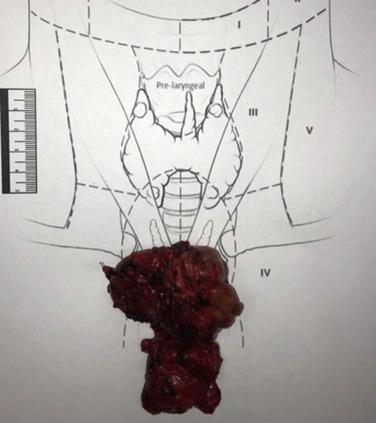
Surgical intervention is warranted in those who are symptomatic due to compression, patients with an intrathoracic goiter and a suspicion or proven malignancy, and occasionally, for cosmesis. In patients who have previously undergone thyroid surgery, fixation of the strap muscles to the trachea may close the thyroid bed medially. This prevents the central bulging of the recurrent goiter, which in primary cases typically allows expansion in the neck without distress or symptoms. This leads to an increase in thyroid compartmental pressure. Therefore patients with recurrent disease are more likely to present with dyspnea, dysphagia, or superior vena cava obstruction. The presence of dysphonia may reflect previous surgical injury to the RLN; however, it may also occur as a result of the RLN being compressed by disease or fibrosis and may occasionally regain function when the thyroid recurrence is removed.
The development of recurrence is time dependent. The average documented time of recurrence is between 8 and 10 years; however, recurrence can be seen up to 20 years after initial resection. Late presentations are thought to represent deferred referrals with long-standing recurrent disease. The development of hyperthyroidism due to a recurrent goiter is also thought to be a function of time. Dorbach and Schicha have demonstrated, in patients with recurrent goiter, a continuous increase in thyroid autonomy occurring at a rate of approximately 4% per year. At 20 years, 70% of all recurrent goiters were autonomous.
The suspicion of malignancy or the presence of malignant disease in nodular recurrence warrants surgical intervention. The reported incidence of cancer in patients who were initially operated on for benign disease varies from 11% to 22%. In high-risk patients such as those who have experienced previous head and neck irradiation, nodularity in the thyroid gland is associated with a high incidence of malignancy of up to 40%, and total thyroidectomy is the preferred approach in these cases.
There are five typical clinical scenarios in which recurrent benign thyroid disease presents itself to the surgeon. These include the following:
Previous thyroid lobectomy with recurrent contralateral disease
Previous thyroid nodulectomy or enucleation of dominant nodules in a multinodular goiter
Recurrence after bilateral subtotal thyroidectomy
Recurrent disease in an embryologic remnant that was not apparent at initial total thyroidectomy
Aggressive benign nodular recurrence after total thyroidectomy
The etiology of recurrent thyroid disease is multifactorial, and the actual pathogenesis remains poorly understood. However, understanding the five clinical scenarios in which recurrence develops is critical if a good outcome is to be achieved. These clinical scenarios will be examined in depth in the following sections.
Perhaps the most common reoperative scenario in benign thyroid surgery occurs when an initial thyroid lobectomy was performed for what was a solitary nodule or unilateral disease. Final pathology revealed a dominant nodule in a multinodular goiter, and nodular recurrence subsequently developed in the contralateral lobe often many years after the initial surgery. This situation allows the second procedure to be performed in a largely unaltered operative field, simplifying dissection of the RLN and parathyroid glands. A second scenario, which is becoming less common, occurs when the patient underwent an initial inadequate resection for nodular goiter. This may have been many decades previously, when such minimalist approaches were more acceptable and commonly will have consisted of either a simple excision or an enucleation of a thyroid nodule, a partial lobectomy, or a “front shave” where just the anterior components of each lobe were resected. Subsequently, bilateral nodular change has progressed in what is essentially an intact thyroid gland albeit with some anterior scarring. A more challenging scenario occurs when the patient underwent a formal bilateral subtotal thyroidectomy or total lobectomy and contralateral subtotal lobectomy and has now developed recurrent disease in the residual posterior remnant or remnants. This clinical scenario presents the surgeon with a technically demanding operative field, which significantly increases the risk of injury to neurovascular structures and parathyroid tissue.
Two further scenarios of benign thyroid tissue regrowth involve recurrent tissue in an embryologic remnant and the rare presentation of aggressive benign nodular recurrence. In the first example the patient has had a “total” thyroidectomy but has developed recurrent disease in one of the embryologic thyroid remnants not visualized or not present at the initial operation. Finally, in the uncommon scenario of aggressive benign nodular recurrence, the patient has had a complete, meticulous total thyroidectomy but has underlying aggressive, albeit benign, nodular disease and develops nodular recurrence in microscopic remnants of residual tissue. This scenario may occur despite suppressive thyroxine therapy. These five clinical scenarios will be examined in detail.
In patients who have had a lobectomy for unilateral nontoxic goiter, 7.4% to 12% will ultimately require reoperation for contralateral disease. The most common pathology seen in a clinically solitary nodule is, in fact, a dominant colloid nodule in a multinodular goiter. Other pathologies may include benign follicular adenoma, thyroid cyst, or nodular change in Hashimoto’s thyroiditis. For patients with a symptomatic solitary nodule, the standard approach is a formal thyroid lobectomy, leaving the normal contralateral side intact. Careful selection of patients will, of course, minimize recurrence rates. Patients selected should have predominantly unilateral nodularity with minimal disease evident on the contralateral side. Small volume subclinical disease is often present in the contralateral lobe, and this common situation requires a careful discussion with the patient regarding the extent of the initial thyroidectomy. In our experience most patients tend to express a clear personal choice between initial lobectomy and total thyroidectomy.
Those who choose lobectomy are typically driven by the desire to avoid thyroid hormone replacement and to minimize operative complications. This group needs to be informed of the associated risk of recurrence from this type of conservative surgery. In addition, it is important to inform the patient that after a lobectomy, hypothyroidism requiring levothyroxine replacement may occur in 14.3% of cases. The experience within the University of Sydney Endocrine Surgical Unit demonstrates that among patients who had a lobectomy for an apparently clinically solitary thyroid only 12% (n = 28/229 patients) required further surgery for recurrent disease. A formal lobectomy therefore appears to be adequate treatment for these patients, because only a relatively small proportion require reoperation for a clinically significant recurrence.
When recurrent nodular goiter does occur, it is important to obtain accurate imaging of both sides of the neck with ultrasound and/or computed tomography (CT). Recurrence on the operated side should be very infrequent if the initial procedure is performed expertly and with care. The surgeon must exclude recurrent disease in the operated thyroid bed before any planned contralateral surgery. Fine needle biopsy of suspicious nodules should be incorporated into the workup. Completion thyroidectomy comprising a second thyroid lobectomy on the side with recurrent nodular change has a low risk of complications. However, it is vital for fiberoptic laryngoscopy to be performed in all cases of recurrent nodular goiter preoperatively. An undiagnosed, well-compensated RLN injury from the initial operation could lead to the serious complication of bilateral RLN palsy requiring tracheostomy. It is imperative that a preexisting RLN palsy is appreciated and the implications of further surgery carefully discussed. Likewise, the approach to the parathyroid glands requires careful consideration and operative technique, and in general we work on the assumption that there is no functioning parathyroid tissue on the operated side. The risk of permanent RLN injury on the reoperative side is typically low in expert hands at 0.77%, with the incidence of permanent hypoparathyroidism being 1.5% and similar to that described in primary surgery.
Inadequate or partial initial operations, such as isthmusectomy, nodule enucleation, or subtotal lobectomy, have been identified as increasing the likelihood of recurrence, even in the setting of an isolated thyroid nodule. These incomplete or atypical initial procedures were usually performed several decades ago, at a time when the principal motivation of many surgeons was to avoid complications by avoiding posterior dissection near the RLN or parathyroid glands. In select patients who present with a solitary toxic nodule, which is not positioned posteriorly in the thyroid lobe, we have performed a minimally invasive thyroid nodulectomy and demonstrated reduced rates of postoperative hypothyroidism. These cases require careful selection, and the long-term durability of this approach is yet to be proven.
Partial thyroidectomy procedures and enucleations are generally discouraged in the modern era of thyroid surgery, and the great majority of expert surgical units now confine their technical approach at initial surgery to either lobectomy or total thyroidectomy. Given the lack of posterior dissection that typically accompanies partial resection procedures, the surgical approach at revision surgery may well be very straightforward, with unaltered tissue planes posteriorly once the initial anterior scarring has been dissected free. Nonetheless, considerable care is still required throughout the revision procedure until the anatomy has been fully displayed because of the frequent uncertainty about what surgical approach was undertaken at the initial operation. This uncertainty may remain even after a review of the first operative note, should it be available. Bilateral recurrent nodular goiter should have a formal total thyroidectomy to reduce the chance of yet a further recurrence in any residual tissue, which may remain with a less than total procedure.
Until the early 1990s, the operation of choice for benign bilateral multinodular goiter was a subtotal procedure, either a bilateral subtotal thyroidectomy, leaving two posterior thyroid remnants, or a thyroid lobectomy on one side and subtotal lobectomy on the other, leaving only one posterior remnant. Complete removal of one thyroid lobe with subtotal lobectomy on the contralateral side is referred to as the Dunhill procedure . Typically 3 to 5 g of thyroid tissue were retained in the region of the ligament of Berry or superior thyroid pole to approximate the volume of a normal thyroid lobe. The rationale for this approach was to lower the risk of damage to the RLN and the parathyroid glands and to preserve thyroid function. Although the rate of transient hypoparathyroidism appears to be lower in subtotal thyroidectomy, the incidence of recurrent goiter is much greater and there is no difference in the rate of permanent RLN palsy and permanent hypocalcemia compared with total thyroidectomy. In addition, very few patients achieve euthyroidism after subtotal thyroidectomy, with up to 84% of patients becoming hypothyroid and requiring levothyroxine replacement. This experience has influenced most high-volume centers to abandon subtotal thyroidectomy in the surgical management of benign goiter.
In recent years, numerous publications have examined comparative data between subtotal and total thyroidectomy for benign multinodular goiter (BMNG). Most of these studies are retrospective in nature and vary widely in their definitions regarding primary disease and recurrence, treatment groups, the length of follow-up, and the actual recurrence rates. However, Agarwal et al. concluded that some recommendations can be made from the available evidence regarding subtotal thyroidectomy. First, subtotal procedures are associated with an increased risk of recurrence of between 2.5% to 42% compared with total thyroidectomy. Second, subtotal procedures provide little added safety in terms of RLN injury and permanent hypoparathyroidism. Finally, subtotal procedures leave a small number of incidentally detected carcinomas inadequately treated. The rate of incidentally detected thyroid carcinoma after a subtotal thyroidectomy is between 3% and 16.6%. Although the majority of these were papillary microcarcinomas or minimally invasive follicular cancers, about one-third were clinically significant follicular or papillary cancers which were undertreated. These results were confirmed by Pappalardo’s group in an Italian study that undertook the largest prospective randomized controlled trial, comparing subtotal with total thyroidectomy for multinodular goiter within a single institution. One hundred and forty-one patients were included in the study group. They demonstrated that there was a 14% recurrence rate in the group who underwent a subtotal thyroidectomy versus 0% who had a total thyroidectomy at a mean follow-up of 14 years. These rates are consistent with the range of recurrences from the pooled data of the other studies and demonstrate that recurrence after a total thyroidectomy is extremely low. The evidence for using total thyroidectomy as the gold standard for the surgical treatment of benign goiter is now very strong. It is, however, contingent on ensuring appropriate surgical technique and, most importantly, providing high quality training for surgical residents and fellows. Through structured training programs that teach meticulous technique, total thyroidectomy can be performed with minimal complications.
Revision surgery for bilateral nodular recurrence after previous subtotal thyroidectomy potentially represents one of the most technically challenging procedures for the thyroid surgeon. The degree of difficulty may be even greater if an experienced thyroid surgeon performed the initial procedure. Under these circumstances, it is likely that both RLNs were exposed at least in part of their cervical course and may well be encased in scar. Likewise, previous bilateral subtotal thyroidectomy typically involves dissection of both the upper and lower thyroid poles. Hence it is highly likely that the parathyroid gland blood supply was significantly disturbed, and the glands themselves may be surrounded by scar tissue. The difficulty regarding parathyroids lies in the fact that there is no way of predicting how many parathyroid glands may have been inadvertently removed or devascularized at the initial procedure. The patient may well be maintaining his or her entire parathyroid hormone (PTH) secretion from a single tenuous parathyroid gland located anteriorly in scar tissue on the surface of the residual lobe with recurrent nodular change. It is important to review the previous operative record and histopathology report; however, even this information cannot clarify which parathyroid glands remain viable with certainty. The surgical approach shown in Figure 9.2 illustrates careful capsular dissection preserving branches of the inferior thyroid artery to preserve the right inferior parathyroid gland ( A ) and superior parathyroid gland ( B ) to maintain parathyroid function. Despite these challenges, with care and appropriate technique, bilateral reoperative surgery can be performed safely. Within the University of Sydney Endocrine Surgery Unit, our experience of bilateral reoperative surgery for recurrent goiter demonstrates that low complication rates can be achieved with careful technique. Our data show that a complication rate of permanent RLN damage and permanent hypoparathyroidism of less than 1% can be achieved even in the reoperative setting.
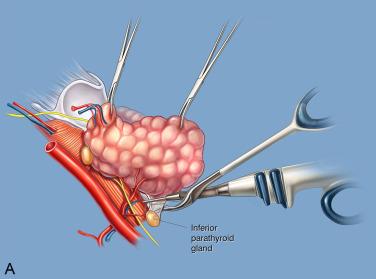
A relatively frequent source of recurrent benign nodular goiter is the growth of thyroid tissue in an embryologic remnant. These remnants of thyroid tissue were either not appreciated at the original procedure or developed into clinically apparent disease from a subclinical or microscopic rest of tissue after total thyroidectomy.
A thorough understanding of the embryologic development of the thyroid will help minimize this type of recurrence (see Chapter 2 , Applied Embryology of the Thyroid and Parathyroid Glands). The thyroid develops from two main structures: the primitive pharynx and the neural crest. It is the first of the body’s endocrine glands to develop, at about the 24th day of gestation. The bulk of the thyroid arises from a proliferation of endodermal cells on the developing pharyngeal floor, forming a visible medial anlage by 16 to 17 days of gestation. This diverticulum migrates caudally to reach the level of the cricoid cartilage. During this period it is attached to the base of the tongue by the thyroglossal duct tract ( Figure 9.3 ). By the end of the seventh week, the gland has assumed its adult shape and location in the lower neck. At this stage its communication with the tongue involutes as the thyroglossal duct tract degenerates and the cells begin to express markers of mature thyrocyte differentiation. There is also a contribution to the thyroid parenchyma derived from lateral neural crest cells which contribute to posterior elements known as the tubercle of Zuckerkandl. Although the exact etiology of aberrant thyroid tissue is not clearly defined, it would seem logical that it represents either arrested or excessive descent of the medial or lateral elements of the thyroid along its embryologic path. It is along these midline and lateral pathways of thyroid descent that embryologic remnants can be encountered.
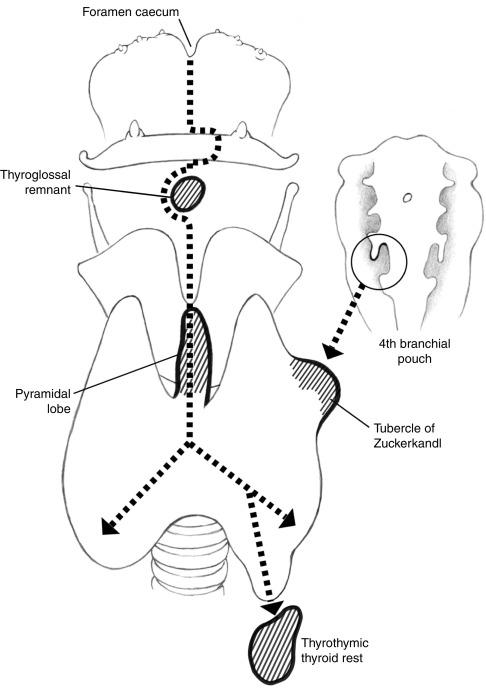
We believe that the presence of these embryologic remnants has considerable clinical importance, especially in the development of recurrent nodular thyroid disease. There are four common sites of embryologic recurrence or persistence of nodular goiter:
Thyroglossal duct tract
Pyramidal lobe of thyroid
Thyroid tissue rests along the thyrothymic tract
Posterior remnants associated with the tubercle of Zuckerkandl.
Remnants of the thyroglossal duct are found in about 7% of the population, but only a small number of these become clinically significant. Anomalies in the region of the thyroglossal duct typically present as a cyst fistula or abscess and most often occur in the pediatric population. Meticulous dissection of the thyroglossal tract is important when undertaking hemithyroidectomy or total thyroidectomy, because recurrence may occur in the region of the tract, particularly in Graves’ disease. The thyroglossal tract extends from the pyramidal lobe of the thyroid and ascends on the anterior surface of the cricothyroid and thyrohyoid membranes and through the body of the hyoid bone up to the base of the tongue. In one-fourth of the patients the thyroglossal duct is off the midline, lying on the lateral aspect of the thyroid cartilage and can easily be missed at primary surgery. Careful inspection of the pyramidal lobe and its cephalad attachments is therefore important when undertaking thyroidectomy.
The pyramidal lobe is the embryologic remnant of the thyroglossal tract, the pathway taken by the thyroid as it descends from the foramen cecum. The pyramidal lobe is variable both in incidence and form. It may be large and nodular or small and string-like depending on the underlying pathology. The pyramidal lobe is apparent in between 15% and 75% of anatomic prosections, and it should essentially be considered a normal part of the thyroid gland. It appears to have a slight male predominance and more commonly arises from the isthmus toward the left-hand side. Its relevance lies in the fact that it may not be readily identified on preoperative scanning and therefore, unless specifically examined for at the primary operation, may be missed. Recurrence in this area is best avoided by routine exposure of the cricothyroid membrane in the midline up to the notch of the thyroid cartilage and careful examination of this region. It is important to understand that the pyramid may become very small and attenuated at the level of the cricothyroid membrane, expanding again with a significant volume of thyroid tissue at the level of the notch of the thyroid cartilage, the most common site of recurrent disease ( Figure 9.4 ). Nodular recurrence in the pyramidal lobe will commonly present with a palpable midline neck mass. Provided it is the sole site of recurrence, reoperative surgery is generally straightforward, requiring only local excision of the pyramidal tract with minimal risk to the RLN and parathyroid glands. Care needs to be taken in the region of the cricothyroid membrane, because this may be scarred and thin, and the membrane may be inadvertently transgressed.
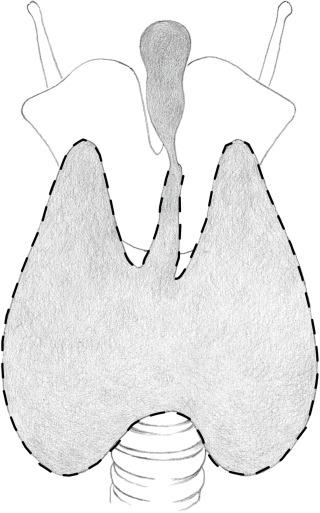
Thyroid rests are deposits of normal thyroid tissue that lie in the line of the thyrothymic tract at or below the lower pole of the thyroid. They are common, with an incidence of over 50% in individuals undergoing thyroid surgery and are found along the course of embryologic thyroid descent. In 57% of patients with thyroid rests, they occur bilaterally. Most thyroid rests are small, with 88% measuring less than 1 cm in maximum diameter. There are four grades of thyroid rest (I to IV), according to their relationship with the thyroid gland. Grade I rests consist of a protrusion of thyroid tissue arising from the inferior aspect of the thyroid gland in the region of the thyrothymic tract. These are distinctly recognizable from the lower border of the thyroid gland itself but retain a direct attachment to the inferior pole of the thyroid gland. Grade II rests include thyroid tissue lying within the thyrothymic tract and are attached to the thyroid by a narrow pedicle of thyroid tissue. Grade III rests are similar but are only attached by a thin fibrovascular core. Grade IV rests have no connection to the thyroid gland and may extend as far down as the anterior mediastinum ( Figure 9.5 ).
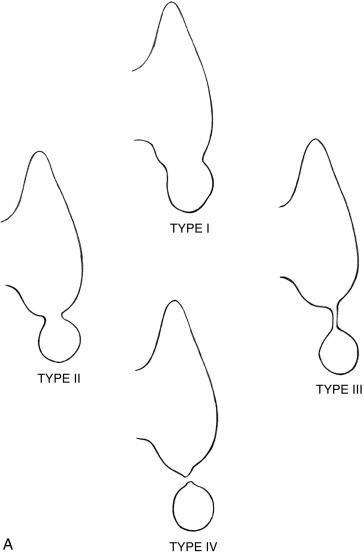
About 20% to 30% of the thyroid rests will be grade III or IV and will be easily missed at primary surgery if the thyrothymic tract is not adequately exposed. A relatively small nodule of thyroid tissue in this location may continue to grow postoperatively and present with a retrosternal recurrence after presumed total thyroidectomy. Indeed, in our unit 12 patients have presented in such a manner and required further surgery. Consequently, because thyroid rests are common, we recommend routine examination of the thyrothymic fatty tissue adjacent to the inferior pole to ensure removal of all thyroid tissue when undertaking thyroidectomy. Nodular recurrence in a thyrothymic thyroid rest may present with a recurrent mass low in the neck or in the suprasternal notch ( Figure 9.6 ). Frequently it may present with a retrosternal recurrence that is not palpable on physical examination of the neck. Such lesions may be found incidentally on chest radiography or CT scan performed to assess unrelated symptoms. If large, they may present with local obstructive symptoms related to tracheal or esophageal compression. Cervical thyrothymic recurrence is readily managed by direct excision, although the inferior parathyroid glands will always be at risk. Additionally, the RLN needs to be carefully searched for, because it may be involved in scar tissue and lie more anteriorly than would normally be anticipated. Retrosternal recurrence after a previous cervical thyroidectomy presents a major surgical challenge. Although most retrosternal goiters can be safely delivered through a cervical approach, the dissection and scarring from the previous thyroidectomy significantly impede the ability to obtain safe access through the neck. Additionally, it is likely that further aberrant vascular supply will have developed after the removal of the cervical component, adding to the dangers of attempted cervical removal. Therefore in our experience, the majority of patients with retrosternal recurrence after a previous total thyroidectomy will likely require a planned mediastinal procedure for safe removal. Indeed, it is very likely that the reason the recurrence developed is that it was inaccessible or not obvious at the time of the initial cervical procedure. The majority of these anterior mediastinal recurrences can be readily mobilized through a manubriotomy or partial sternotomy. Larger and more posterior recurrences may require full sternotomy or thoracotomy.
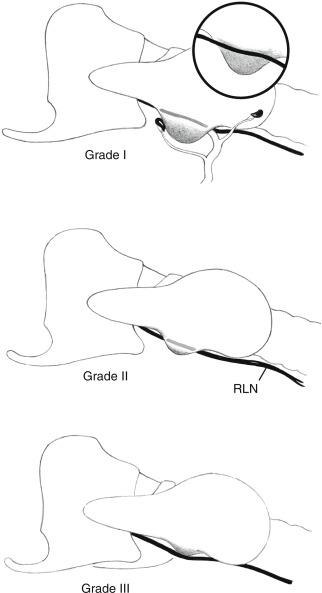
The tubercle of Zuckerkandl is a posterior extension of the thyroid, which may give rise to persistent or recurrent disease. The tubercle of Zuckerkandl was first described by Zuckerkandl in 1902 as the “processus posterior glandulae thyroidea.” This is a common anatomic feature of the thyroid that is apparent in more than 50% of thyroidectomies and is more obvious on the right side. Its significance lies in the fact that enlargement and nodular change in the tubercle may be primarily retroesophageal and not observed at initial surgery. As a result, the posterior component may be inadvertently retained at initial thyroidectomy, leading to posterior persistence or recurrence (see Figure 9.6 ).
In rare circumstances, a failure in the normal descent of the thyroid can result in the development of an accessory or ectopic thyroid gland. Accessory thyroid glands were initially described in 1965 and can be categorized into three groups depending on their location: cranial, caudal, or lateral. A normal thyroid gland may be present or absent. The cranial glands usually lie inferior to the hyoid bone on the thyrohyoid membrane or the thyroid cartilage. They may rarely be found as a lingual thyroid or in an intralingual position. Caudal accessory glands are located between the lower border of the thyroid and the aortic arch. Lateral glands arise from a failure of the lateral anlage of the thyroid to fuse with its median counterpart during embryologic development and lie in the lateral compartment of the neck in any of the anatomic levels I to V. One such position includes submandibular localization adjacent to the submandibular salivary gland. In practice, these rare accessory glands are an uncommon cause of recurrent goiter, and we do not routinely look for them during primary procedures.
Become a Clinical Tree membership for Full access and enjoy Unlimited articles
If you are a member. Log in here